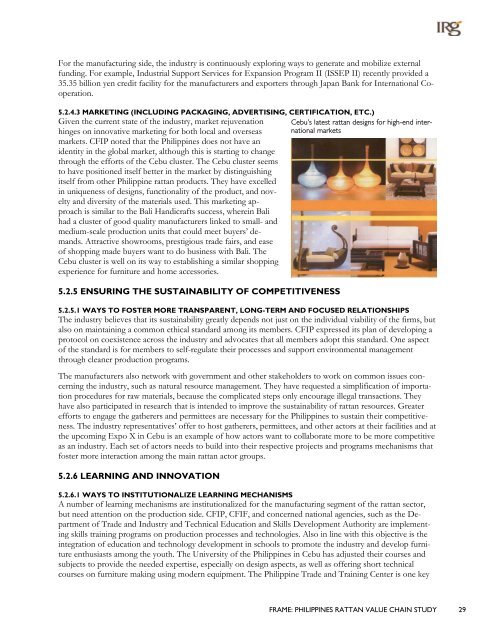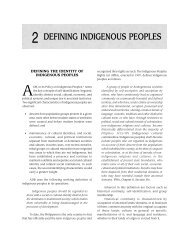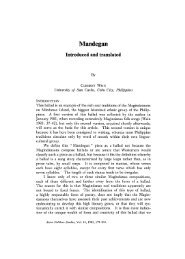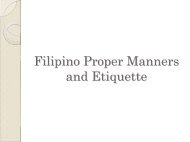PHILIPPINES RATTAN VALUE CHAIN STUDY - Aboutphilippines
PHILIPPINES RATTAN VALUE CHAIN STUDY - Aboutphilippines
PHILIPPINES RATTAN VALUE CHAIN STUDY - Aboutphilippines
Create successful ePaper yourself
Turn your PDF publications into a flip-book with our unique Google optimized e-Paper software.
For the manufacturing side, the industry is continuously exploring ways to generate and mobilize externalfunding. For example, Industrial Support Services for Expansion Program II (ISSEP II) recently provided a35.35 billion yen credit facility for the manufacturers and exporters through Japan Bank for International Cooperation.5.2.4.3 MARKETING (INCLUDING PACKAGING, ADVERTISING, CERTIFICATION, ETC.)Given the current state of the industry, market rejuvenation Cebu’s latest rattan designs for high-end internationalmarketshinges on innovative marketing for both local and overseasmarkets. CFIP noted that the Philippines does not have anidentity in the global market, although this is starting to changethrough the efforts of the Cebu cluster. The Cebu cluster seemsto have positioned itself better in the market by distinguishingitself from other Philippine rattan products. They have excelledin uniqueness of designs, functionality of the product, and noveltyand diversity of the materials used. This marketing approachis similar to the Bali Handicrafts success, wherein Balihad a cluster of good quality manufacturers linked to small- andmedium-scale production units that could meet buyers’ demands.Attractive showrooms, prestigious trade fairs, and easeof shopping made buyers want to do business with Bali. TheCebu cluster is well on its way to establishing a similar shoppingexperience for furniture and home accessories.5.2.5 ENSURING THE SUSTAINABILITY OF COMPETITIVENESS5.2.5.1 WAYS TO FOSTER MORE TRANSPARENT, LONG-TERM AND FOCUSED RELATIONSHIPSThe industry believes that its sustainability greatly depends not just on the individual viability of the firms, butalso on maintaining a common ethical standard among its members. CFIP expressed its plan of developing aprotocol on coexistence across the industry and advocates that all members adopt this standard. One aspectof the standard is for members to self-regulate their processes and support environmental managementthrough cleaner production programs.The manufacturers also network with government and other stakeholders to work on common issues concerningthe industry, such as natural resource management. They have requested a simplification of importationprocedures for raw materials, because the complicated steps only encourage illegal transactions. Theyhave also participated in research that is intended to improve the sustainability of rattan resources. Greaterefforts to engage the gatherers and permittees are necessary for the Philippines to sustain their competitiveness.The industry representatives’ offer to host gatherers, permittees, and other actors at their facilities and atthe upcoming Expo X in Cebu is an example of how actors want to collaborate more to be more competitiveas an industry. Each set of actors needs to build into their respective projects and programs mechanisms thatfoster more interaction among the main rattan actor groups.5.2.6 LEARNING AND INNOVATION5.2.6.1 WAYS TO INSTITUTIONALIZE LEARNING MECHANISMSA number of learning mechanisms are institutionalized for the manufacturing segment of the rattan sector,but need attention on the production side. CFIP, CFIF, and concerned national agencies, such as the Departmentof Trade and Industry and Technical Education and Skills Development Authority are implementingskills training programs on production processes and technologies. Also in line with this objective is theintegration of education and technology development in schools to promote the industry and develop furnitureenthusiasts among the youth. The University of the Philippines in Cebu has adjusted their courses andsubjects to provide the needed expertise, especially on design aspects, as well as offering short technicalcourses on furniture making using modern equipment. The Philippine Trade and Training Center is one keyFRAME: <strong>PHILIPPINES</strong> <strong>RATTAN</strong> <strong>VALUE</strong> <strong>CHAIN</strong> <strong>STUDY</strong> 29
















